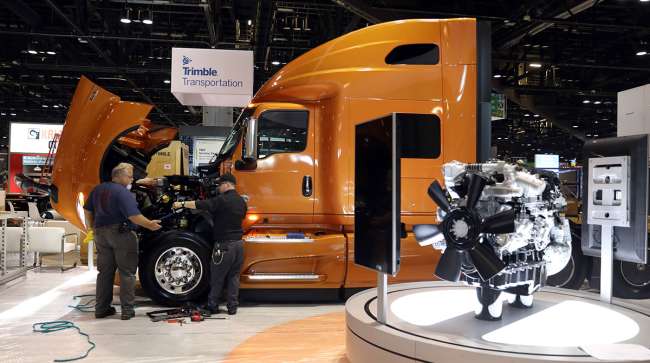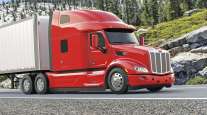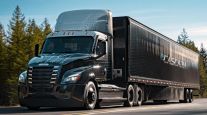Senior Reporter
US Class 8 Sales in May Climb Past 20,000, Adding to Recent Momentum

[Stay on top of transportation news: Get TTNews in your inbox.]
U.S. Class 8 retail sales in May rose 13.9% compared with a year earlier to just clear 20,000, Wards Intelligence reported.
A near-term trend is building. Sales in the two previous months also percolated higher compared with almost every month in the past 12 months.
May sales were 20,713 compared with 18,187 in the 2021 period.
Despite broader macro uncertainty about Russia/Ukraine, interest rates, and potential recession, the prevailing theme in trucks is largely unchanged: long backlogs and supply-chain constrained production continue to keep new orders trending...https://t.co/1LtokjJteh pic.twitter.com/EC20UZt12K
— ACT Research (@actresearch) June 7, 2022
Steve Tam, vice president of ACT Research, called May’s sales volume pretty much what was expected.
“If they could build more, they could sell more. But that’s a theme people are tired of hearing about, I think,” he said. “But in the great, grand scheme of things, May came in above replacement level for the U.S. market.”
He said the truck makers were figuring out how to operate in this environment, making inroads in terms of some of the challenges on the supply chain front. “It’s progress, but progress coming painfully slow, unfortunately.”
The annual U.S. replacement level is about 190,000 units, or about 16,000 orders a month, according to ACT Research.
Sales through the first five months fell 2% to 89,897 compared with 91,714 a year earlier.
“The relatively healthy Class 8 unit sales numbers over the past few months are an encouraging sign that OEMs are making progress with their supply chains while also demonstrating that carriers have not lost their appetite for capacity,” said Dan Clark, head of BMO Transportation Finance.
“Indeed, although weakness in spot market freight grabs all the headlines, most for-hire truck freight channels through the contract market, which has remained relatively steady. Likewise, larger and better-capitalized carriers primarily operating outside the spot market are getting preferential allocations of any new equipment that becomes available,” Clark added.
All truck makers but two increased sales in May compared with a year earlier.
Volvo Trucks North America climbed the most, up 80.2% to 2,546 and a 12.3% share in May.
“The total market came back a little stronger than expected in May. Volvo Trucks North America had a good month,” said Magnus Koeck, vice president of strategy at VTNA. “We look forward to a strong June but anticipate continuing labor and material shortages throughout the supply chain.”
International, a brand of Navistar Inc., grew 22.9% to 2,799 and a 13.5% share.
Paccar Inc.’s Peterbilt Motors Co. brand climbed 15.1% to 3,375 and a 16.3% share.
“April and May have been pretty good months for our factories. I think we have a better supply of components than we maybe anticipated five or six weeks ago,” said Paccar Chief Financial Officer Harrie Schippers. “That’s across the board, so in the U.S. and Europe we have been able to increase build rates, as we hoped for.”

How can trucking companies persuade new drivers to stay? Host Mike Freeze brings in onboarding expert Anthony Pellegrino of Ag Energy Transport. Tune in above or by going to RoadSigns.TTNews.com.
Western Star rose 14.3% to 511 and a 2.5% share.
Market leader Freightliner climbed 9.8% to 7,307 and a 35.3% share.
Western Star and Freightliner are brands of Daimler Truck North America.
There was a flip side: Mack Trucks dropped 11.2% to 1,372 and a 6.6% share.
Mack and VTNA are brands of Volvo Group.
“Mack, like all truck makers, has been impacted in various ways by global supply chain constraints, which has affected deliveries from Mack and body companies,” said Jonathan Randall, senior vice president of sales and commercial operations at Mack Trucks. “We’re doing all we can to deliver trucks to our customers as quickly as possible. Our backlog remains strong and demand remains high.”
Kenworth Truck Co., also a Paccar brand, fell 4% to 2,803 and a 13.5% share.
Looking toward truck sales to come, Michael Dozier, senior vice president at Paccar Inc., said for new state emissions regulations set to launch in 2024 in California the truck maker has a very mature program to sell progressively more zero-emission trucks in the state (including 75% of Classes 4-8 straight trucks and 40% of truck tractor by 2035, and 100% of heavy-duty sleepers by 2040).
As for a separate federal emissions proposal scheduled for 2027, he said, “We are not at the peak yet of the product development curve, and there are still some decisions being made on what the appropriate technologies will be, the right mix of pieces to address the regulation as currently written.”
The Environmental Protection Agency’s proposed rule for 2027 includes, for now, two possible options to further reduce air pollution, including ozone, particulate matter and greenhouse gases.
Meanwhile, are we heading for a mild recession? “Although the BMO economics team is not predicting a recession, their GDP estimates have been trending lower as the risks have increased,” Clark said.
“If there is a recession,” he continued, “the first half of next year seems like a time frame to watch out for, given the chilling effect of a steep ramp in interest rates combined with the usual seasonal pause in economic activity. Construction starts, and the labor market, in particular, will be worth watching as the canaries in the recession coal mine.”
Want more news? Listen to today's daily briefing below or go here for more info:




